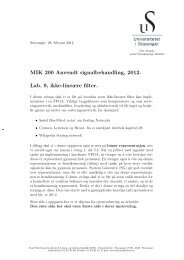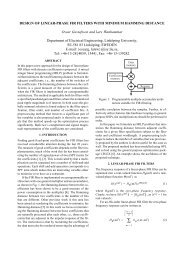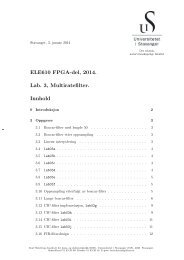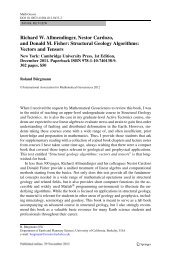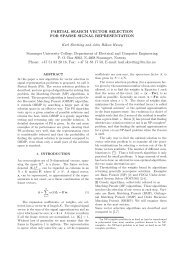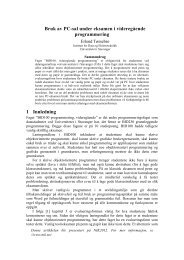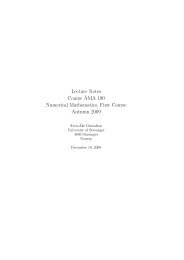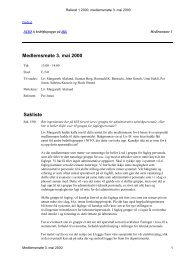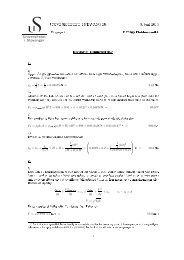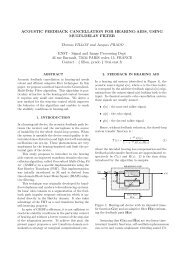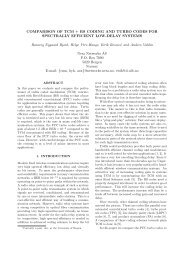MODELING OF LOW SALINITY EFFECTS IN SANDSTONE OIL ...
MODELING OF LOW SALINITY EFFECTS IN SANDSTONE OIL ...
MODELING OF LOW SALINITY EFFECTS IN SANDSTONE OIL ...
Create successful ePaper yourself
Turn your PDF publications into a flip-book with our unique Google optimized e-Paper software.
2 OMEKEH, EVJE, AND FRIISrecovery. Austad et al.[6] describe a model of local pH increase as a result of a chemicalprocess involving the release of divalent ions from the rock surface.• Clay dispersion[40]: This mechanism describes a model in which oil-wetted clays aredispersed from the rock surface in low salinity environment. The desorption of divalentions can only aid such mechanism since divalent ions promotes clay flocculation.1.2. Main objective of this work. As an attempt to develop some basic understanding of howsuch mechanisms possibly will have an impact on core flooding experiments in the context of lowsalinity studies, we will in this work formulate a Buckley-Leverett two-phase flow model where thewetting state, as represented by the relative permeability functions, has been coupled to a multipleion exchange (MIE) process. In other words, in this work we have singled out MIE as the onlymechanisms for taking into consideration possible low salinity effects. More precisely, according tothe proposed MIE mechanism, we chose to link desorption of the divalent ions bonded to the rocksurface to a change of relative permeability functions such that more oil can be mobilized. Thiswill allow us to do some systematic investigations how different brine compositions can possiblyhave an impact on the oil recovery.Hence, the purpose of this work is to, motivated by laboratory experiments with flooding ofvarious seawater like brines, formulate a concrete water-rock chemical system relevant for sandstoneflooding experiments with focus on low salinity effects. Main components in the proposedmodel are:• Consider modeling of sandstone core plugs with a certain amount of clay attached to itthat is responsible for the ion exchange process;• Include a multiple ion exchange process that involve Ca 2+ , Mg 2+ , and Na + ions;• Implement a coupling between release of divalent ions (calcium and magnesium) from therock surface and a corresponding change of water-oil flow functions (relative permeabilitycurves) such that more oil can be mobilized.The resulting model takes the form of a system of convection-diffusion equations:(1)s t + f(s, β ca , β mg ) x = 0,(sC na + M c β na ) t + (C na f(s, β ca , β mg )) x = (D(s, ϕ)C na,x ) x ,(sC cl ) t + (C cl f(s, β ca , β mg )) x = (D(s, ϕ)C cl,x ) x ,(sC ca + M c β ca ) t + (C ca f(s, β ca , β mg )) x = (D(s, ϕ)C ca,x ) x ,(sC so ) t + (C so f(s, β ca , β mg )) x = (D(s, ϕ)C so,x ) x ,(sC mg + M c β mg ) t + (C mg f(s, β ca , β mg )) x = (D(s, ϕ)C mg,x ) x .For completeness, since we are interested in flooding of seawater like brines (high salinity andlow salinity), we have included chloride C cl and sulphate C so , despite that these will act onlyas tracers in our system. In other words, these ions are not directly involved in the water-rockchemistry model in terms of the MIE process. The unknown variables we solve for are watersaturation s (dimensionless), and concentrations C na , C cl , C ca , C so , C mg (in terms of mole perliter water). β na , β ca , and β mg are the concentrations of sodium, calcium, and magnesium bondedto the rock surface. Note that β i = β i (C na , C ca , C mg ), for i = na, ca, mg. Moreover, f(s, β ca , β mg )is the fractional flow function. The dependence on β ca and β mg is due to the proposed couplingbetween wettability alteration and desorption of the divalent cations Ca 2+ and Mg 2+ from therock surface. The quantity M c represents the mass of clay whereas D = D(ϕ, s) is the diffusioncoefficient which accounts for both molecular diffusion and mechanical dispersion. More detailsleading to this model are given in the subsequent sections. In the model (1), a characteristic timeτ = ϕLv Tand length scale L have been introduced.Such a model can potentially be a helpful tool for visualizing in a systematic manner therelatively complicated interplay between (i) change in injecting brine compositions; (ii) change information water compositions; (iii) clay content/capacity. This can also serve as a help to designnew laboratory experiments. In particular, we observe a number of different scenarios:



